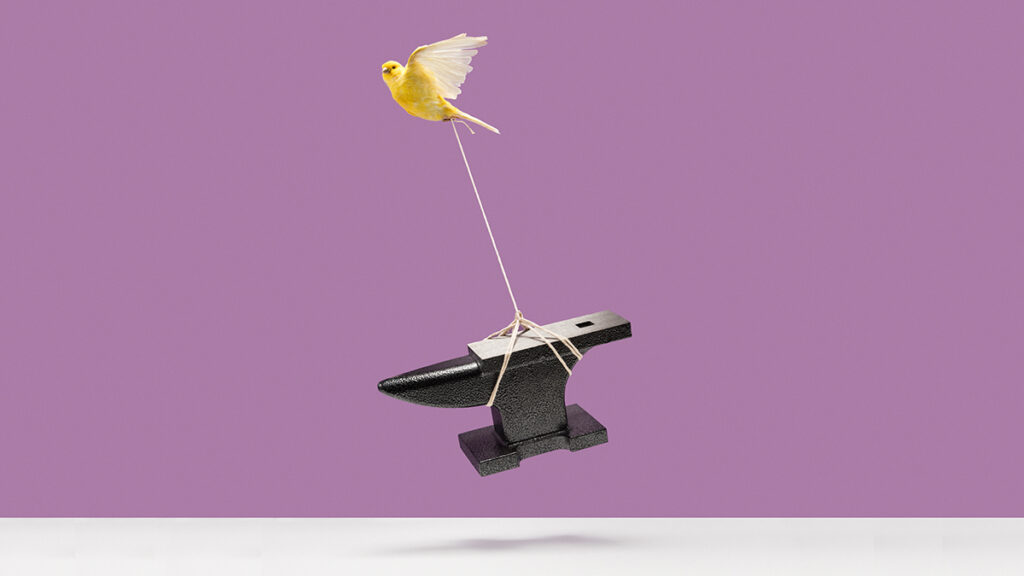Most feedback accentuates the negative. During formal employee evaluations, discussions invariably focus on “opportunities for improvement,” even if the overall evaluation is laudatory. Informally, the sting of criticism lasts longer than the balm of praise. Multiple studies have shown that people pay keen attention to negative information. For example, when asked to recall important emotional events, people remember four negative memories for every positive one. No wonder most executives give and receive performance reviews with all the enthusiasm of a child on the way to the dentist.
Traditional, corrective feedback has its place, of course; every organization must filter out failing employees and ensure that everyone performs at an expected level of competence. Unfortunately, feedback that ferrets out flaws can lead otherwise talented managers to overinvest in shoring up or papering over their perceived weaknesses, or forcing themselves onto an ill-fitting template. Ironically, such a focus on problem areas prevents companies from reaping the best performance from its people. After all, it’s a rare baseball player who is equally good at every position. Why should a natural third baseman labor to develop his skills as a right fielder?
The alternative, as the Gallup Organization researchers Marcus Buckingham, Donald Clifton, and others have suggested, is to foster excellence in the third baseman by identifying and harnessing his unique strengths. It is a paradox of human psychology that while people remember criticism, they respond to praise. The former makes them defensive and therefore unlikely to change, while the latter produces confidence and the desire to perform better. Managers who build up their strengths can reach their highest potential. This positive approach does not pretend to ignore or deny the problems that traditional feedback mechanisms identify. Rather, it offers a separate and unique feedback experience that counterbalances negative input. It allows managers to tap into strengths they may or may not be aware of and so contribute more to their organizations.
During the past few years, we have developed a powerful tool to help people understand and leverage their individual talents. Called the Reflected Best Self (RBS) exercise, our method allows managers to develop a sense of their “personal best” in order to increase their future potential. The RBS exercise is but one example of new approaches springing from an area of research called positive organizational scholarship (POS). Just as psychologists know that people respond better to praise than to criticism, organizational behavior scholars are finding that when companies focus on positive attributes such as resilience and trust, they can reap impressive bottom-line returns. (For more on this research, see the sidebar “The Positive Organization.”) Thousands of executives, as well as tomorrow’s leaders enrolled in business schools around the world, have completed the RBS exercise.
In this article, we will walk you through the RBS exercise step-by-step and describe the insights and results it can yield. Before we proceed, however, a few caveats are in order. First, understand that the tool is not designed to stroke your ego; its purpose is to assist you in developing a plan for more effective action. (Without such a plan, you’ll keep running in place.) Second, the lessons generated from the RBS exercise can elude you if you don’t pay sincere attention to them. If you are too burdened by time pressures and job demands, you may just file the information away and forget about it. To be effective, the exercise requires commitment, diligence, and follow-through. It may even be helpful to have a coach keep you on task. Third, it’s important to conduct the RBS exercise at a different time of year than the traditional performance review so that negative feedback from traditional mechanisms doesn’t interfere with the results of the exercise.
Used correctly, the RBS exercise can help you tap into unrecognized and unexplored areas of potential. Armed with a constructive, systematic process for gathering and analyzing data about your best self, you can burnish your performance at work.
Step 1 – Identify Respondents and Ask for Feedback
The first task in the exercise is to collect feedback from a variety of people inside and outside work. By gathering input from a variety of sources—family members, past and present colleagues, friends, teachers, and so on—you can develop a much broader and richer understanding of yourself than you can from a standard performance evaluation.
As we describe the process of the Reflected Best Self exercise, we will highlight the experience of Robert Duggan (not his real name), whose self-discovery process is typical of the managers we’ve observed. Having retired from a successful career in the military at a fairly young age and earned an MBA from a top business school, Robert accepted a midlevel management position at an IT services firm. Despite strong credentials and leadership experience, Robert remained stuck in the same position year after year. His performance evaluations were generally good but not strong enough to put him on the high-potential track. Disengaged, frustrated, and disheartened, Robert grew increasingly stressed and disillusioned with his company. His workday felt more and more like an episode of Survivor.
Seeking to improve his performance, Robert enrolled in an executive education program and took the RBS exercise. As part of the exercise, Robert gathered feedback from 11 individuals from his past and present who knew him well. He selected a diverse but balanced group—his wife and two other family members, two friends from his MBA program, two colleagues from his time in the army, and four current colleagues.
Robert then asked these individuals to provide information about his strengths, accompanied by specific examples of moments when Robert used those strengths in ways that were meaningful to them, to their families or teams, or to their organizations. Many people—Robert among them—feel uncomfortable asking for exclusively positive feedback, particularly from colleagues. Accustomed to hearing about their strengths and weaknesses simultaneously, many executives imagine any positive feedback will be unrealistic, even false. Some also worry that respondents might construe the request as presumptuous or egotistical. But once managers accept that the exercise will help them improve their performance, they tend to dive in.
Within ten days, Robert received e-mail responses from all 11 people describing specific instances when he had made important contributions—including pushing for high quality under a tight deadline, being inclusive in communicating with a diverse group, and digging for critical information. The answers he received surprised him. As a military veteran and a technical person holding an MBA, Robert rarely yielded to his emotions. But in reading story after story from his respondents, Robert found himself deeply moved—as if he were listening to appreciative speeches at a party thrown in his honor. The stories were also surprisingly convincing. He had more strengths than he knew.
Step 2 – Recognize Patterns
In this step, Robert searched for common themes among the feedback, adding to the examples with observations of his own, then organizing all the input into a table. (To view parts of Robert’s table, see the exhibit “Finding Common Themes.”) Like many who participate in the RBS exercise, Robert expected that, given the diversity of respondents, the comments he received would be inconsistent or even competing. Instead, he was struck by their uniformity. The comments from his wife and family members were similar to those from his army buddies and work colleagues. Everyone took note of Robert’s courage under pressure, high ethical standards, perseverance, curiosity, adaptability, respect for diversity, and team-building skills. Robert suddenly realized that even his small, unconscious behaviors had made a huge impression on others. In many cases, he had forgotten about the specific examples cited until he read the feedback, because his behavior in those situations had felt like second nature to him.
The RBS exercise confirmed Robert’s sense of himself, but for those who are unaware of their strengths, the exercise can be truly illuminating. Edward, for example, was a recently minted MBA executive in an automotive firm. His colleagues and subordinates were older and more experienced than he, and he felt uncomfortable disagreeing with them. But he learned through the RBS exercise that his peers appreciated his candid alternative views and respected the diplomatic and respectful manner with which he made his assertions. As a result, Edward grew bolder in making the case for his ideas, knowing that his boss and colleagues listened to him, learned from him, and appreciated what he had to say.
Other times, the RBS exercise sheds a more nuanced light on the skills one takes for granted. Beth, for example, was a lawyer who negotiated on behalf of nonprofit organizations. Throughout her life, Beth had been told she was a good listener, but her exercise respondents noted that the interactive, empathetic, and insightful manner in which she listened made her particularly effective. The specificity of the feedback encouraged Beth to take the lead in future negotiations that required delicate and diplomatic communications.
For naturally analytical people, the analysis portion of the exercise serves both to integrate the feedback and develop a larger picture of their capabilities. Janet, an engineer, thought she could study her feedback as she would a technical drawing of a suspension bridge. She saw her “reflected best self” as something to interrogate and improve. But as she read the remarks from family, friends, and colleagues, she saw herself in a broader and more human context. Over time, the stories she read about her enthusiasm and love of design helped her rethink her career path toward more managerial roles in which she might lead and motivate others.
Step 3 – Compose Your Self-Portrait
The next step is to write a description of yourself that summarizes and distills the accumulated information. The description should weave themes from the feedback together with your self-observations into a composite of who you are at your best. The self-portrait is not designed to be a complete psychological and cognitive profile. Rather, it should be an insightful image that you can use as a reminder of your previous contributions and as a guide for future action. The portrait itself should not be a set of bullet points but rather a prose composition beginning with the phrase, “When I am at my best, I…” The process of writing out a two- to four-paragraph narrative cements the image of your best self in your consciousness. The narrative form also helps you draw connections between the themes in your life that may previously have seemed disjointed or unrelated. Composing the portrait takes time and demands careful consideration, but at the end of this process, you should come away with a rejuvenated image of who you are.
In developing his self-portrait, Robert drew on the actual words that others used to describe him, rounding out the picture with his own sense of himself at his best. He excised competencies that felt off the mark. This didn’t mean he discounted them, but he wanted to assure that the overall portrait felt authentic and powerful. “When I am at my best,” Robert wrote,
I stand by my values and can get others to understand why doing so is important. I choose the harder right over the easier wrong. I enjoy setting an example. When I am in learning mode and am curious and passionate about a project, I can work intensely and untiringly. I enjoy taking things on that others might be afraid of or see as too difficult. I’m able to set limits and find alternatives when a current approach is not working. I don’t always assume that I am right or know best, which engenders respect from others. I try to empower and give credit to others. I am tolerant and open to differences.
As Robert developed his portrait, he began to understand why he hadn’t performed his best at work: He lacked a sense of mission. In the army, he drew satisfaction from the knowledge that the safety of the men and women he led, as well as the nation he served, depended on the quality of his work. He enjoyed the sense of teamwork and variety of problems to be solved. But as an IT manager in charge of routine maintenance on new hardware products, he felt bored and isolated from other people.
The portrait-writing process also helped Robert create a more vivid and elaborate sense of what psychologists would call his “possible self”—not just the person he is in his day-to-day job but the person he might be in completely different contexts. Organizational researchers have shown that when we develop a sense of our best possible self, we are better able make positive changes in our lives.
Step 4 – Redesign Your Job
Having pinpointed his strengths, Robert’s next step was to redesign his personal job description to build on what he was good at. Given the fact that routine maintenance work left him cold, Robert’s challenge was to create a better fit between his work and his best self. Like most RBS participants, Robert found that the strengths the exercise identified could be put into play in his current position. This involved making small changes in the way he worked, in the composition of his team, and in the way he spent his time. (Most jobs have degrees of freedom in all three of these areas; the trick is operating within the fixed constraints of your job to redesign work at the margins, allowing you to better play to your strengths.)
Robert began by scheduling meetings with systems designers and engineers who told him they were having trouble getting timely information flowing between their groups and Robert’s maintenance team. If communication improved, Robert believed, new products would not continue to be saddled with the serious and costly maintenance issues seen in the past. Armed with a carefully documented history of those maintenance problems as well as a new understanding of his naturally analytical and creative team-building skills, Robert began meeting regularly with the designers and engineers to brainstorm better ways to prevent problems with new products. The meetings satisfied two of Robert’s deepest best-self needs: He was interacting with more people at work, and he was actively learning about systems design and engineering.
Robert’s efforts did not go unnoticed. Key executives remarked on his initiative and his ability to collaborate across functions, as well as on the critical role he played in making new products more reliable. They also saw how he gave credit to others. In less than nine months, Robert’s hard work paid off, and he was promoted to program manager. In addition to receiving more pay and higher visibility, Robert enjoyed his work more. His passion was reignited; he felt intensely alive and authentic. Whenever he felt down or lacking in energy, he reread the original e-mail feedback he had received. In difficult situations, the e-mail messages helped him feel more resilient.
Robert was able to leverage his strengths to perform better, but there are cases in which RBS findings conflict with the realities of a person’s job. This was true for James, a sales executive who told us he was “in a world of hurt” over his work situation. Unable to meet his ambitious sales goals, tired of flying around the globe to fight fires, his family life on the verge of collapse, James had suffered enough. The RBS exercise revealed that James was at his best when managing people and leading change, but these natural skills did not and could not come into play in his current job. Not long after he did the exercise, he quit his high-stress position and started his own successful company.
Other times, the findings help managers aim for undreamed-of positions in their own organizations. Sarah, a high-level administrator at a university, shared her best-self portrait with key colleagues, asking them to help her identify ways to better exploit her strengths and talents. They suggested that she would be an ideal candidate for a new executive position. Previously, she would never have considered applying for the job, believing herself unqualified. To her surprise, she handily beat out the other candidates.
Beyond Good Enough
We have noted that while people remember criticism, awareness of faults doesn’t necessarily translate into better performance. Based on that understanding, the RBS exercise helps you remember your strengths—and construct a plan to build on them. Knowing your strengths also offers you a better understanding of how to deal with your weaknesses—and helps you gain the confidence you need to address them. It allows you to say, “I’m great at leading but lousy at numbers. So rather than teach me remedial math, get me a good finance partner.” It also allows you to be clearer in addressing your areas of weakness as a manager. When Tim, a financial services executive, received feedback that he was a great listener and coach, he also became more aware that he had a tendency to spend too much time being a cheerleader and too little time keeping his employees to task. Susan, a senior advertising executive, had the opposite problem: While her feedback lauded her results-oriented management approach, she wanted to be sure that she hadn’t missed opportunities to give her employees the space to learn and make mistakes.
In the end, the strength-based orientation of the RBS exercise helps you get past the “good enough” bar. Once you discover who you are at the top of your game, you can use your strengths to better shape the positions you choose to play—both now and in the next phase of your career.





